Supermicro SYS-E100-12T-H Review: Fanless Tiger Lake for Embedded Applications
by Ganesh T S on June 8, 2022 8:00 AM EST- Posted in
- Systems
- Fanless
- Embedded
- Supermicro
- Passive Cooling
- Tiger Lake
System Performance: Multi-Tasking
One of the key drivers of advancments in computing systems is multi-tasking. On mobile devices, this is quite lightweight - cases such as background email checks while the user is playing a mobile game are quite common. Towards optimizing user experience in those types of scenarios, mobile SoC manufacturers started integrating heterogenous CPU cores - some with high performance for demanding workloads, while others were frugal in terms of both power consumption / die area and performance. This trend is now slowly making its way into the desktop PC space.
Multi-tasking in typical PC usage is much more demanding compared to phones and tablets. Desktop OSes allow users to launch and utilize a large number of demanding programs simultaneously. Responsiveness is dictated largely by the OS scheduler allowing different tasks to move to the background. Intel's Alder Lake processors work closely with the Windows 11 thread scheduler to optimize performance in these cases. Keeping these aspects in mind, the evaluation of multi-tasking performance is an interesting subject to tackle.
We have augmented our systems benchmarking suite to quantitatively analyze the multi-tasking performance of various platforms. The evaluation involves triggering a VLC transcoding task to transform 1716 3840x1714 frames encoded as a 24fps AVC video (Blender Project's 'Tears of Steel' 4K version) into a 1080p HEVC version in a loop. VLC internally uses the x265 encoder, and the settings are configured to allow the CPU usage to be saturated across all cores. The transcoding rate is monitored continuously. One complete transcoding pass is allowed to complete before starting the first multi-tasking workload - the PCMark 10 Extended bench suite. A comparative view of the PCMark 10 scores for various scenarios is presented in the graphs below. Also available for concurrent viewing are scores in the normal case where the benchmark was processed without any concurrent load, and a graph presenting the loss in performance.
| UL PCMark 10 Load Testing - Digital Content Creation Scores | |||

| UL PCMark 10 Load Testing - Productivity Scores | |||

| UL PCMark 10 Load Testing - Essentials Scores | |||
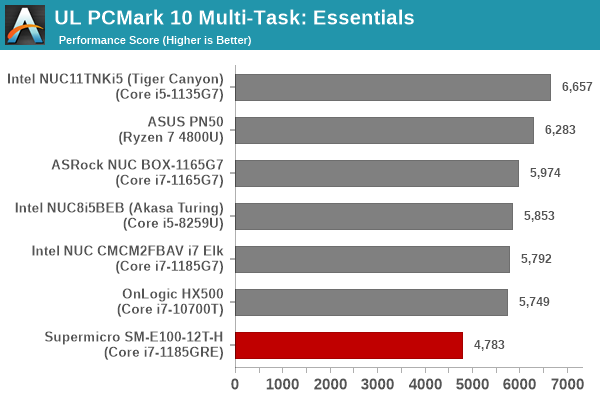
| UL PCMark 10 Load Testing - Gaming Scores | |||
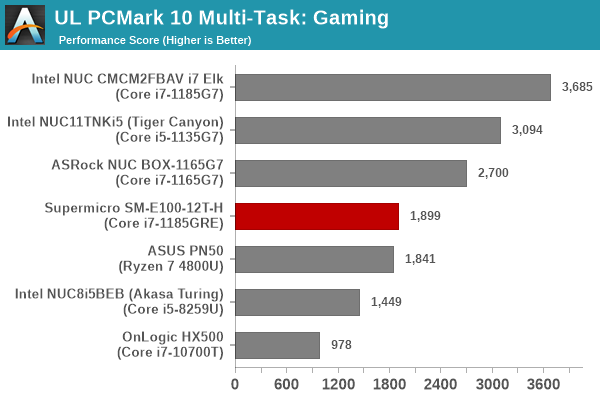
| UL PCMark 10 Load Testing - Overall Scores | |||
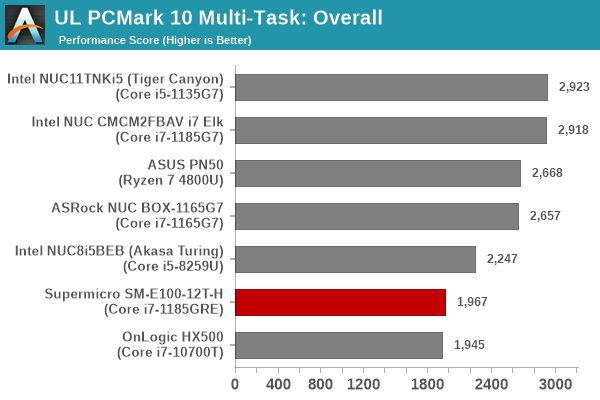
With a TDP of just 15W and a low core count compared to other systems, the SM-E100-12T-H suffers severe performance loss - often upwards of 50% in these workloads. The only saving grace is the performance loss for GPU workloads, which comes in the middle of the pack.
Following the completion of the PCMark 10 benchmark, a short delay is introduced prior to the processing of Principled Technologies WebXPRT4 on MS Edge. Similar to the PCMark 10 results presentation, the graph below show the scores recorded with the transcoding load active. Available for comparison are the dedicated CPU power scores and a measure of the performance loss.
| Principled Technologies WebXPRT4 Load Testing Scores (MS Edge) | |||

The analysis made for the PCMark 10 workload components holds true here also, with the SM-E100-12T-H suffering a 60% loss in performance when subject to simultaneous software transcoding load.
The final workload tested as part of the multitasking evaluation routine is CINEBENCH R23.
| 3D Rendering - CINEBENCH R23 Load Testing - Single Thread Score | |||
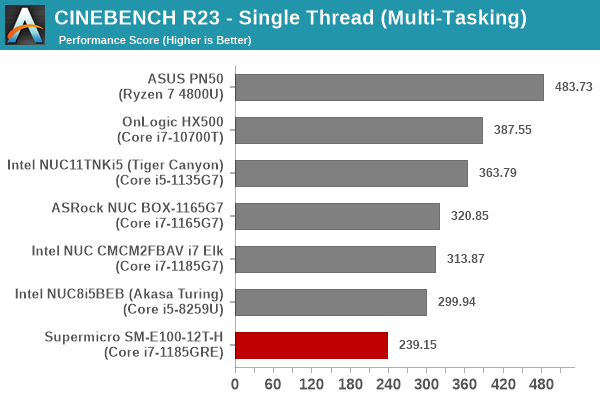
| 3D Rendering - CINEBENCH R23 Load Testing - Multiple Thread Score | |||
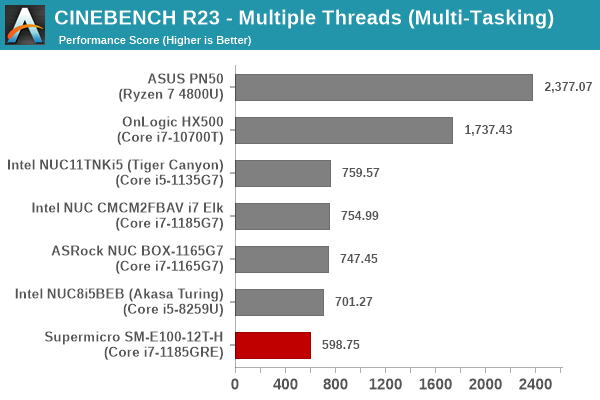
CINEBENCH R23 is even more brutal, with the performance loss for the SM-E100-12T-H around 80% in both cases. However, we see almost all systems struggling as both the transcoding workload and the 3D rendering workload are active across all cores simultaneously.
After the completion of all the workloads, we let the transcoding routine run to completion. The monitored transcoding rate throughout the above evaluation routine (in terms of frames per second) is graphed below.
The first pass is around 7.5 fps with no concurrent loads. As various other workloads are processed, the transcoding rate gets pushed down to around 4.5 fps, which is to be expected.


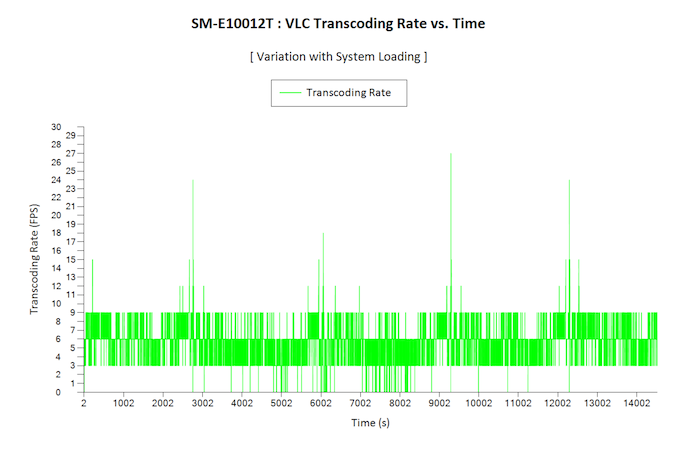








16 Comments
View All Comments
kgardas - Wednesday, June 8, 2022 - link
Great little box. Your article although short is very valuable due to your choice of filming going thorough setup. This is a *BIG* thing here. Indeed, due to GRE SoC used I've been very carefully looking into "In-Band ECC" option in the setup. Not seen it anywhere. Perhaps most close but very confusing is "Enable RH Prevention" -- with help text "Actively prevent Row Hammer" -- if this is "In-Band ECC" or not is beyond my imagination -- asking SMicro for clarification would be great here.kgardas - Wednesday, June 8, 2022 - link
Also important question is: country of origin. China or by any chance something more democratic and trustful?nandnandnand - Wednesday, June 8, 2022 - link
Trust No OneSSNSeawolf - Wednesday, June 8, 2022 - link
Supermicro is an American company.kgardas - Wednesday, June 8, 2022 - link
Sure, but a lot of their products are made in P.R.C. Hence caution is reasonable IMHO.andychow - Wednesday, June 8, 2022 - link
Which product isn't made in China? The iPhone is made in China, and so is pretty much every cellphone.Supermicro moved their production from China to Taiwan a couple of years back. There was a rumor that the Chinese government had added a secret chip. Of course, no such chip was ever found on any board, even after Supermicro audited the production and actively investigated. But rumors online stay alive, so they moved to Taiwan.
kgardas - Thursday, June 9, 2022 - link
Majority of Kontron and all Kontron previous Fujitsu boards are made in EU/Germany. Some of Asus/Gigabyte boards are made in Taiwan. Supermicro ordered plans were divided 2/3 in P.R.C 1/3 in Taiwan few years back. Hence the question of coutry of origin.Yes, agree, mobile phone industry is doomed with nearly all P.R.C. production this is why such device can't be tolerated in security sensitive environment.
ricebunny - Thursday, June 9, 2022 - link
If data privacy is your concern than avoiding Made in China products will not help you. Our own government has no shortage of means or moral restraint for that matter to spy on us.Threska - Thursday, June 9, 2022 - link
Why spy on us, when everyone's leaking, even the government.bwj - Wednesday, June 8, 2022 - link
For a box like this is seems like it would have been useful the evaluate the ability of the i225 NICs to move packets. I've had some problems with the i225-v but I don't know if they are universal with the i225 of all kinds.